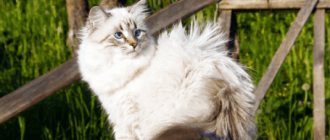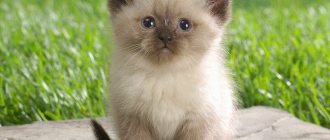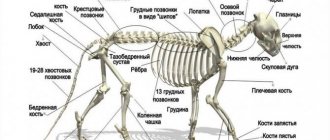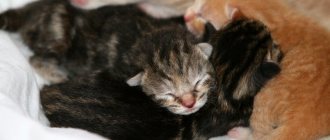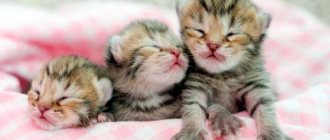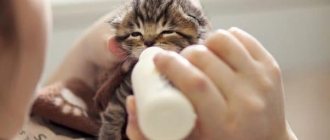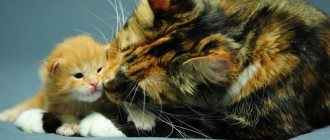22376Administration
1
The period of active growth and weight gain plays a special role in the development of a kitten. Determining the weight of a kitten at each stage of its development is necessary in order to notice deviations in the direction of underweight or overweight in time and take action. In order to control the kitten's weight by month, you can use a special table.
It is based on the average increase for each month in the period from 1 to 12. However, when using the table data, it should be taken into account that the weight of different breeds at the same age may differ slightly. For example, Maine Coon cubs weigh significantly more at birth than British breed cubs. Several other factors also influence the weight and size of a kitten:
- Floor. At birth, boys and girls usually do not differ much in weight, but after a few months this difference becomes noticeable;
- Number of individuals in the litter. It is known that the more individuals born in one litter, the greater their deviation towards underweight from the average statistical norm;
- Proper nutrition for cats during pregnancy and feeding. If during pregnancy and feeding the cat received all the substances necessary for her body, then the likelihood of harmoniously developing offspring becomes higher;
- A balanced diet for the baby after weaning him from the cat is one of the factors that is significant in terms of influence on the kitten’s normal weight;
- The health status of the animal. Violation of general health can negatively affect the development of an individual and normal weight gain.
© shutterstock
Kitten weight by month: table
Weight depends on many factors, which include breed, gender, size of parents, individual characteristics, etc. At birth, a kitten can weigh from 80 to 150 g. For example, Maine Coons, on average, give birth to 130-gram kittens, while British cats – 100 grams, and outbred cats weigh about 90 g at birth.
The table below shows averages of how much animals weigh depending on age and breed:
| Age | Maine Coon | British cat | Sphinx | Outbred |
| 1 Week | 180-250 g | 110-230 g | 100-220 g | 100-250 g |
| 2 week | 280-350 g | 150-300 g | 130-300 g | 150-300 g |
| 3 week | 420-570 g | 210-500 g | 200-430 g | 200-500 g |
| 1 month | 560-730 g | 250-650 g | 230-590 g | 250-650 g |
| 2 months | 1.1-1.5 kg | 450-900g | 420-800 g | 400-1kg |
| 3 months | 1.7-2.2 kg | 1-2.5 kg | 900-2 kg | 1-2 kg |
| 4 months | 2.7-3.7 kg | 1.7-3.5 kg | 1.3-2.7 kg | 1.5-2.5 kg |
| 5 months | 2.9-5.3 kg | 2.2-4 kg | 2.1-3.9 kg | 2-3 kg |
| 6 months | 3.2-6 kg | 2.3-4.5 kg | 2.2-4.3 kg | 2.5-4 kg |
| 7 months | 3.5-6.5 kg | 2.4-5 kg | 2.3-4.6 kg | 2.5-4.5 kg |
| 8 months | 3.8-6.7 kg | 2.5-5.5 kg | 2.4-4.9 kg | 2.5-5 kg |
| 9 months | 4.1-7 kg | 2.5-5.9 kg | 2.5-5.3 kg | 2.5-5.5 kg |
| 10 months | 4.3-7.7 kg | 2.6-6.4 kg | 2.6-5.8 kg | 2.6-6 kg |
| 11 months | 4.4 -8 kg | 2.7-6.8 kg | 2.7-6.4 kg | 2.8-6.5 kg |
| 1 year | 4.6-9 kg | 3-7 kg | 3-7 kg | 3-7 kg |
Kitten at birth
Newborn sphinxes weigh 80-100 g with a body length of 10-12 cm. Like their furry counterparts, they are helpless - they are still blind and deaf. But already at the age of three days they are able to “get” food for themselves - to squeeze milk out of their mother’s nipples. For about a month it will be their main food, a source of antibodies for the formation of immunity.
Newborn hairless kitten:
Weight gain in the first month
The first four weeks of life are characterized by the most intensive growth. The weight of a kitten in the 1st month can increase up to 15 g every day. At the end of this period, it can be two or even three times greater than at birth. Such intensive growth is noticeable to the naked eye. If at this age there is a slight gain in body weight, then you need to seek help from a veterinarian to diagnose and correct the situation.
In the first month, the kitten needs intensive care and good nutrition. The optimal diet is provided by mother's breast milk. However, a cat cannot always feed its offspring for various reasons. In this case, the role of “mother” falls on the pet owner. The best substitute for mother's milk are special industrial mixtures, the composition of which duplicates the natural components as much as possible. The dosage and frequency of feeding depend on the age and size of the animal. So, in the first week he should be fed about 4 ml every 2-4 hours, and in the second week - every 4-6 hours, 5 ml. With proper nutrition, by the end of the fourth week he will weigh 300-400 g, his first teeth will grow and he can already be given additional food.
In addition to rapid growth, signs of your pet’s health in the first four weeks of life will include:
- ability to stand on one’s paws (way and not confidently);
- active behavior;
- healthy sleep;
- regular bowel movements.
Normal growth and development The average weight of a kitten at birth is 90 - 1 Ugr (varies 80-140g). Depends on many factors: breed, number of kittens in the litter, health of the female. Poor weight gain is associated with illness and birth defects. Weigh the kitten after birth, then 12 hours later, and daily for the first 2 weeks of life.
The first sign of the disease may be poor weight gain: slight weight loss is normal during the first 24 hours after birth, but further weight loss and poor weight gain are abnormal. A weight gain of 50-100g per week (10-15g per day) is considered normal; During the first two weeks of life, the kitten's weight should double. During the first two weeks, a healthy newborn kitten is awake (about 8 hours a day) and sleeps (about 16 hours a day). Well-fed kittens have a round belly and are happy; hungry people scream excessively and have sunken stomachs. Sick kittens: weak, suck poorly, isolated from the rest of the litter.
Sense and perception organs: Eyes open on the 10th day (the period can vary from 2 to 16 days); kittens become visually oriented by the 4th week of life; the iris of the eye remains bluish-gray for up to 4 weeks. At birth, the ear canal is blocked by ridges of skin, but gradually widens and opens by the 9th day of life (from 6 to 17 days). Newborn kittens have a good sense of smell. Pain sensitivity is present at birth, so pain relief is necessary for any painful procedure. They begin to crawl well at the age of 7-14 days; and walk at the age of 2 weeks; by licking (the belly and perioral area), the female stimulates defecation and urination; At the age of 3 weeks, independent defecation and urination appears. Immunity Kittens receive passive immunity during the first 18 hours of life (before the alimentary canal closes) through colostrum; transplacental movement of immunoglobulin occurs in the animal. The female's milk contains almost the same amount of immunoglobulin as colostrum, but the composition of the milk changes during lactation. The lowest amount of IgG occurs at 4-6 weeks of life and coincides with the period of greatest susceptibility to infection. Lack of passive immunity in weaned kittens and in kittens that were weaned in the first 18 hours of life, due to the possibility of neonatal isoerythrolysis. Treatment may be a subcutaneous injection of blood from an adult cat of the same blood type (15 ml/100g body weight, divided into 3 doses over 24 hours). Kittens without subcutaneous blood injection will begin to produce IgG at 4 weeks of age; They are most susceptible to diseases before 6 weeks of age.
Veterinary examination of a newborn kitten The veterinarian must know all the information (medical history). About the kitten and the parents. About the female, disease, nutrition, vaccination, infectious diseases, the influence of genetic factors, etc. About the progress of pregnancy and birth (especially for a kitten less than 2 weeks old) About previous litters.
Examine the environment, temperature, humidity, sanitary conditions, parasitism, infectious diseases. Examine kittens less than 4 weeks of age in the presence of a female at home or in a cattery. Examine newborns carefully on a clean, warm surface; wash your hands first, put on gloves. Equipment needed: scale, pediatric rectal thermometer, otoscope, flashlight, stethoscope with a clean pediatric tip with bell (2 cm) and diaphragm (3 cm). Pay attention to the kitten's socialization, physical condition, spatial orientation, posture, breathing movements; Healthy newborn kittens have a strong sucking reflex.
Temperature: Normal (rectal) temperature in newborn kittens is 97-98°F (36-37°C). Temperature gradually rises to 100°F (38°C) and remains at this level until 4 weeks of age. During the first few weeks, kittens are poikilothermic. There is no shudder reflex for 6 days (the blood vessels are unable to constrict or retain heat). By 4 weeks of life, kittens finally become thermostable.
Look closely for pathologies such as: Cleft palate or cleft lip: Umbilical hernia or infection (omphalophlebitis). The umbilical cord is dry and without pus; disappears on the 3rd day after birth. The fontanelles are open. Limb deformity. Chest deformities (flat chest, pectus excavatum). Urogenital or rectal closure. Rule out disease: Check for painful urination/defecation by stimulating the perineum with a soft, moist tampon and mineral oil. Check for constipation or diarrhea (present) in 60% of affected newborns), as well as hematuria or pigmenturia. Eyes: Examine the eyeball and eyelids for pathology and neonatal conjunctivitis. The threat reflex does not appear until the kitten is 21 days old. The pupils begin to respond to light soon after the eyes open at 21 days. Extension strabismus is considered normal until 8 weeks of age. When the eye opens, the cornea is slightly clouded. Assessing the fundus may be difficult before 6 weeks of age. Teeth: The first primary teeth appear at 3-4 weeks of age - the incisors and canines. (Minor molars) teeth) Premolars appear at the age of 5-6 weeks.Normal formula for the development of primary teeth = 2(13/3, Cl/1, P3/2). There is no rule for baby teeth. Bytown Cat Hospital • 422 McArthur Ave. • Ottawa, Ontario, Canada K1K 1G6 Phone 613-741-2460 •* Fax 613-741-8463 Eyes/Skin/Mucous Membrane : Examine the pinna for injury or skin disease. The ear canals are difficult to examine with an otoscope when the kitten is less than 4 weeks old. The coat should be clean and shiny. Healthy newborn kittens may have hyperemic mucosa before 7 days of age; while in sick newborn kittens the mucous membrane is pale, gray, cyanotic. Cardiovascular/Respiratory System : Newborn kittens have lower blood pressure than adult kittens, high cardiac output and rapid heart rate. Listening to the heartbeat can possibly be difficult at a very early age. Functional murmur in newborns may result from hypoproteinemia, fever, or sepsis. A faint murmur is rarely a sign of illness and is more common in puppies rather than kittens; murmurs that appear at 4 months of age need to be investigated. Congenital heart disease usually produces a loud murmur and is accompanied by precordial tremor. Normal heart rate can be over 200 beats per minute and vary (220-260). The normal number of breathing movements is 15-35 breaths per minute. Abdomen: A full, rounded abdomen in a well-fed kitten is normal; a highly bloated, enlarged abdomen may indicate aerophagia. A normal liver and spleen cannot be felt (not palpated). The kidneys are always palpable. A full stomach can be felt. The intestine is palpable as a fluid-filled loop of intestine, mobile and painless. The bladder is also palpable, mobile and painless.
Veterinary diagnostics Laboratory tests: Blood collection: jugular vein, 1 -ml syringe, 25-g or 26-g needle; use water instead of alcohol to treat your hair; Slow blood sampling is necessary to avoid clotting. Place the kitten on its back with its front paws pressed to its stomach, head and neck extended - the best position for venipuncture. 0.5 ml of blood can be used for basic tests:
PCV using microhematocrit and refractometer. CBC: determination of the number of different types of blood cells. BUN: determination of urine content in the blood. Use a glycometer to determine the amount of glucose in your blood (note that this device works slowly.)
Urine is collected for chemical analysis; cystocentosis should be performed very carefully in small kittens. Examination of feces for giardiasis, coccidiosis and intestinal helminths. Bytown Cat Hospital • 422 McArthur Ave. • Ottawa, Ontario, Canada K1K 1G6 Phone 613-741-2460 •* Fax 613-741-8463 Other diagnostic techniques: Autopsy: not performed often; the main goal is information that will help save the rest of the litter or future litters. To achieve the best result, the whole body (refrigerated, but not frozen) should be submitted to the pathologist. If necessary, freezing is preferable to avoid tissue decomposition and some information may be obtained. autopsy, histopathology detection
Primary therapy:
Hypothermia (chilling): Occurs when temperature is below 78-95°F (26-35°C); characterized by weak breathing, weakened immune system, weak heartbeat, coma, paralysis of the digestive system. Warm slowly for 30 minutes to 2 hours; to a maximum temperature of 101°F (36.3°C) to avoid dehydration. Methods: incubator, oxygen cage, intensive care (intraosseous) (35-37°C), warm water heating pad, red lamp, warm water bottle. Room temperature should be 85-95°F (29-35°C) and humidity 55-65% (use a hygrometer). Turn kittens over frequently and take rectal temperature. Do not try to feed a kitten with hypothermia until you warm it up (vomiting is likely).
Hypoglycemia: Most often occurs due to an underdeveloped liver and rapid depletion of glycogen stores. Progresses to sepsis, hypothermia and refusal to eat. Diagnosed if blood glucose is less than 50 mg/dL (<3 mmol/L). Prolonged attacks lead to brain damage and possible damage to the heart muscle since the newborn's heart uses glucose rather than fatty acids to produce energy. Clinical signs: lethargy, anorexia. If there is no hypothermia or dehydration, give 5-10% dextrose via (1 ml/100g body weight) tube every hour until the condition returns to normal. If absolutely necessary, corn syrup can be rubbed into the gums (for example, Karo Kago® Corn Syrup). If the newborn is in critical condition, qualified veterinary care is required: Intravenous or intraosseous injection of 10-20% dextrose (1 ml/1 00g). Next, 2.5 to 5% dextrose solution in a balanced solution of electrolytes, intraosseous or intravenous. Do not use hypertonic dextrose solution, otherwise the skin may peel off.
Tube feeding: All equipment must be thoroughly washed and sterilized: o Feeding tube: size 5 French for 300g kittens, 8 Fr for 300g kittens. o Syringes (3- and 10-ml). o Artificial or homemade formula Warm the tube and syringe in warm water. Measure the probe from the tip of the nose to the last rib and make a mark on the tube (the tube should be measured weekly as the kitten grows, a new mark is made). Fill the tube with a mixture heated to a temperature of 95-100°F (35-38°C), place the kitten on the chest with his head up. Insert the tube along the left side of the mouth into the esophagus, to the mark. The tube should enter easily without difficulty; only slight resistance from the kitten is possible. Slowly introduce the required amount of mixture. Before inserting the tube, twist it to prevent air from entering and quickly straighten it. Normal stomach volume is approximately 40-50 ml/kg (4-5ml/100g). The manufacturer of the mixture must provide its recommendations for feeding; feedings are made every 2-4 hours in the first week of a kitten’s life. Bytown Cat Hospital • 422 McArthur Ave. • Ottawa, Ontario, Canada K1K 1G6 Phone 613-741-2460 •* Fax 613-741-8463
Diarrhea is the most common problem when using formula: reduce the amount of formula consumed, dilute by 50% with water or electrolyte solution for several feedings, try a different formula. Energy required by a kitten in the first few weeks of life 22-38 kcal/lOOg/day Hypovolemia/dehydration: Diarrhea, vomiting or refusal to eat is a common cause; the balancing mechanism is poorly developed and renal function is underdeveloped. Difficult to assess hydration level; Skin turgor is not reliable due to high fat content and low water content. The mucous membrane should be moist; even if it is hypermic or pink in color it can remain moist even with severe dehydration. Pale mucous membranes may indicate 10% dehydration or more. Normal newborn urine is clear and colorless; during the period of dehydration, the urine is dark in color with a sediment of more than 1.017. If the kitten is normothermic (no bowel dysfunction, no severe dehydration), a subcutaneous injection can be used. Intravenous injection: good for severe dehydration. Intraperitoneal injection can cause a side effect - peritonitis. Intraosseous injection is used when intravenous injection is not possible; solutions, blood, and medicinal solutions can be used.
Drug treatment Newborns: Body size exceeds body weight. Thin layer of fat and little muscle mass; high water content (affects the distribution of the medicine). Low levels of protein and albumin (affects the effect of medications). • Immature kidneys and liver (affect the absorption of medications). • High permeability of the blood-brain barrier. The intestinal flora is poorly developed and is easily disrupted by oral antimicrobials. • The presence of milk in the stomach may inactivate or reduce the absorption of certain medications. Intravenous and intraosseous injections are preferable to subcutaneous and intramuscular injections. Many drugs have not been tested on newborn kittens; The ideal dose and frequency of use is very often unknown. In general, the dose should be reduced by 30-50%; the interval between doses is extended by an additional 2-4 hours. Bytown Cat Hospital • 422 McArthur Ave. • Ottawa, Ontario, Canada K1K 1G6 Phone 613-741-2460 •* Fax 613-741-8463
Antibiotics: Avoid: aminoglycosides (nephrotoxicity, ototoxicity), chloramphenicol (levomycytin, chloramphenicol), bone marrow (suppression), tetracycline (effect on skeleton and teeth, renal and liver failure) Use of sulfonamides, if there is no anemia, characterized by decreased appetite in newborns, quinolones are safe, broad-spectrum antibiotics for kittens; Due to poor absorption, newborn kittens are administered subcutaneously or with food p-lactams - antibiotics, the choice of which is preferable (new generation). Other safe drugs: pyrantel, fenbendazole, antidiarrheals containing koalin. Medicines that should be used carefully: glucocorticoids, non-steroidal anti-inflammatory drugs, metronidazole, ivomectin, griseofulvin.
Causes of death of kittens:
Mortality rates range from 4% to 30% (in some nurseries); Generally the mortality rate is 10-20% in kennels at 4 weeks of age. Early lactation mortality rates greater than 20% should be thoroughly investigated
The main dangerous periods: pregnancy (miscarriage, induced abortion), childbirth (stillbirth), the period of the first 2 weeks of life, and the period immediately after weaning. Investigation of causes involves/treatment of specific kittens, diagnostic examination, full necropsy (including bacteria and histopathology); kittens should be refrigerated (including histopathology) and the entire body submitted to a pathologist for examination. Main causes: low birth weight, birth defects, trauma, unbalanced nutrition, maternal negligence, environmental factors, infectious diseases and parasites, neonatal isoerythrolysis (N1)
Low birth weight Many causes, difficult to identify: prematurity, hereditary diseases (example: inborn errors of metabolism), birth defects, intrauterine infections, etc. Kittens that weigh less than 75 grams at birth very rarely survive. Check out the average kitten birth weight (for each breed). Kittens that lose more than 10% of their total weight at birth have a poor chance of survival.
Birth defects The causes of birth defects are varied (example: genetic disorders, drug effects, infections, spontaneous pathologies). The death of more than 20% of liveborn and stillborn kittens is associated with anatomical pathology. Defects can be the following: Cleft palate, craniofacial defects (Burmese, American Shorthair - skull defects), heart defects, congenital gastric cleft, skeletal pathology, conjoined (Siamese) twins.
Trauma Death in 10% of kittens is due to birth trauma or trauma during the first three days of life May also be caused by maternal neglect or cannibalism Bytown Cat Hospital • 422 McArthur Ave. • Ottawa, Ontario, Canada K1K 1G6 Phone 613-741-2460 •* Fax 613-741-8463
Poor nutrition The first feeding should occur within the first two hours after birth; colostrum is absorbed only during the first 16-18 hours. First-born kittens often have to wait if the birth is long-term. After a difficult birth, kittens may be too weak or injured to nurse effectively. Improper milk production can be caused by: First-time cat, old cat, sick or malnourished cat and unbalanced diet, difficult birth, family history, mastitis, kittens in the litter are small and weak.
Environment Environmental stressors (overcrowding, noise, poor ventilation, etc.) can undermine maternal care. Temperature fluctuations can be detrimental to newborn kittens; high room temperature, plus high humidity provoke some infectious diseases (mneumonia, mastitis); low temperature provokes chills.
Infectious diseases High mortality rates due to infectious diseases occur during the first two weeks of life and the weaning period. Pathogenesis includes: Strep, Mycoplasma, herpes virus, parvovirus, FeLV, FIV, IPC, Toxoplasma, E. coli, Pasteurella, Staphylococci, Bordetella, Chlamydophila. Strep is common. canis, coliform bacteria (E. coli), respiratory viruses, especially herpes viruses.
Bacterial infection such as E. coli and Strep. canis can be one of the leading causes of death in kittens, especially at 5-10 days of age. The main route of bacterial infection is the navel; treat the umbilical cord with a 2% iodine solution or chlorhexidine solution. Examine the navel every day, check for swelling, redness, and pus.
Kitten weight at 2-3 months
During this period, intensive weight gain continues, although not as active as before. For every 30 days, the kitten almost doubles in size, and by the end of the 3rd month it will weigh approximately 1.5-2 kg. He can already eat soft food, so you should diversify his diet and don’t forget about water. Stores sell special food for kittens, which may come in the form of a pate or soft pieces in a sauce. Since the small pet is already actively exploring the territory, it is necessary to limit its access to adult food, which will be too tough for it.
Siberian cat - description of the breed
The Siberian cat is a truly unique breed. The beauty of these animals fascinates absolutely everyone who has seen them at least once.
Siberian cats require special care and maintenance. And before purchasing such a fluffy forest cat for your home, you should learn about the characteristics of Siberians. In fact, this is very useful: people make much fewer mistakes due to ignorance or inexperience.
I would immediately like to draw your attention to the color of the pets of this breed. It is diverse and can be not only a classic (or natural) look, but also a red Siberian cat, tortoiseshell, smoky, bicolor, monocolor (red, ash, blue, white) and even marbled and brindle.
The norm is 4-5 months
At this age, the average weight of a kitten is 1.5-3 kg. The period of intensive growth has ended, but the pet still continues to gain weight. At the end of the 5th month, males can reach 4 kg.
Your pet still needs to eat baby food frequently. The number of feedings is up to 5 times. Diets should be chosen with the maximum protein content, which is necessary for the normal development of the growing predator’s body. Industrially produced food is marked with the appropriate inscription “For kittens”. However, it is necessary to carefully study the composition in order to choose a quality nutrition.
Feeding and caring for Siberian kittens
Surprisingly, such a thick coat of the breed does not require endless care. The grooming process includes brushing during the molting period, otherwise 1-2 times a month will be more than enough.
The animal's ears and eyes are cleaned once a week with damp, clean cloths or napkins. Nails need to be trimmed 1-2 mm as they grow, 2 times a month.
Proper maintenance of a Siberian cat requires that you sometimes let it go outside.


